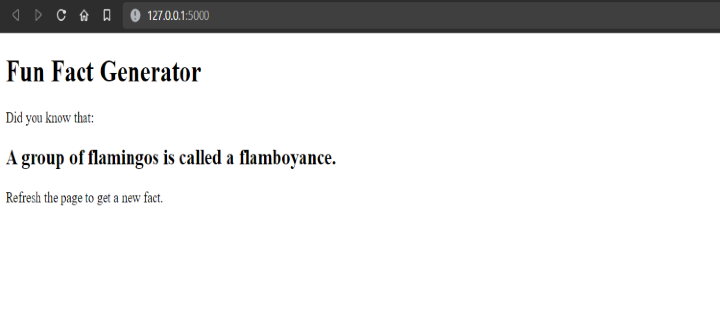Fun fact generator web app in Python
Flask provides many features such as database access, processing user input and dynamic data passing. Use HTML and simple Python coding to create an efficient and user-friendly online application. Python allows us to process data and provide users with customized experiences, while Flask makes it easier to create web applications. Data items are also displayed in the browser using HTML. By the end of this course, you will have a working fun fact generator web application.
set up
Before we begin, please make sure we have the necessary frameworks and libraries installed. This project only requires Flask and Python 3.x. Using pip, Python's package installer, you can install Flask. Once you have Python and Flask installed, now start building the application.
pip install flask
Fun Fact Generator web application can be used in various scenarios. For example, it can be integrated into a trivia game or used as a conversation starter at social gatherings. It can also be expanded to include additional categories of facts, such as science, history, or literature. The possibilities are endless!
The folder structure will look like this −
Project Folder/ ├── app.py └── templates/ └── index.html
algorithm
Import the required modules: Flask, render template and random.
Create an instance of the Flask class and assign it to a variable.
Make a list of fascinating facts and put them into a variable.
Use the @app decorator to define the route for the web application home page.
Create a function that takes a random number as a starting point. Use the choose() function to select a random fact from a list of facts and save the result in a variable.
To display the "index.html" template and provide random fact variables as input, use the render_template() function.
Start the web application using a script with flask run
The fact variable will be displayed on the HTML page using Jinja2 template syntax.
Use a text editor to create a file called "index.html" and save it there. The "templates" directory will be generated in the same location as the Python code files where the Flask application code is located. To give the web page the desired structure, add HTML code. Display random facts on an HTML page using Jinja2 template syntax with double curly braces and variable names. After saving the file run the Flask application.
The Chinese translation ofExample
is:Example
from flask import Flask, render_template
import random
app = Flask(__name__)
facts = [
"A group of flamingos is called a flamboyance.",
"The longest English word is 189,819 letters long and takes more than 3 hours to pronounce.",
"The shortest war in history was between Britain and Zanzibar in 1896. Zanzibar surrendered after just 38 minutes.",
"There are more possible iterations of a game of chess than there are atoms in the known universe.",
"The first webcam was created to check the coffee pot at Cambridge University.",
"Bananas are berries, but strawberries are not."
]
@app.route("/")
def home():
fact = random.choice(facts)
return render_template("index.html", fact=fact)
if __name__ == "__main__":
app.run(debug=True)
Index.html [must be saved in the templates/ folder]
<html>
<head>
<meta charset="UTF-8">
<meta name="viewport" content="width=device-width, initial-scale=1.0">
<meta http-equiv="X-UA-Compatible" content="ie=edge">
<title>Fun Fact Generator</title>
</head>
<body>
<h1 id="Fun-Fact-Generator">Fun Fact Generator</h1>
<p>Did you know that:</p>
<h2 id="fact">{{ fact }}</h2>
<p>Refresh the page to get a new fact.</p>
</body>
</html>
Output

After refreshing, a different fact will be generated as shown below

This code sets up a Flask web application for generating random fun facts. The code imports the Flask module and the render_template function, which allows the use of HTML templates to generate web pages. Facts are stored in a list, and the home() function uses the random.choice() method to generate a random fact from the list. These facts are then passed to the index.html template using the render_template() function, and the resulting web page displays the facts along with some text. index.htmlThe file should be saved in the "templates" folder and contains HTML code for displaying interesting facts as well as some heading and paragraph text. When the application executes, Flask runs a local server on the local computer and the user can access the URL displayed in the console to view the web page.
in conclusion
In this article, we explored how to use Python and Flask to build a web application that creates interesting facts. Updated settings for required libraries and frameworks, as well as the syntax, file formats, and coding standards involved. Overall, it contains detailed instructions for creating a fully working online application using Python and Flask.
The above is the detailed content of Fun fact generator web app in Python. For more information, please follow other related articles on the PHP Chinese website!

Hot AI Tools

Undresser.AI Undress
AI-powered app for creating realistic nude photos

AI Clothes Remover
Online AI tool for removing clothes from photos.

Undress AI Tool
Undress images for free

Clothoff.io
AI clothes remover

AI Hentai Generator
Generate AI Hentai for free.

Hot Article

Hot Tools

Notepad++7.3.1
Easy-to-use and free code editor

SublimeText3 Chinese version
Chinese version, very easy to use

Zend Studio 13.0.1
Powerful PHP integrated development environment

Dreamweaver CS6
Visual web development tools

SublimeText3 Mac version
God-level code editing software (SublimeText3)

Hot Topics
 1377
1377
 52
52
 Do mysql need to pay
Apr 08, 2025 pm 05:36 PM
Do mysql need to pay
Apr 08, 2025 pm 05:36 PM
MySQL has a free community version and a paid enterprise version. The community version can be used and modified for free, but the support is limited and is suitable for applications with low stability requirements and strong technical capabilities. The Enterprise Edition provides comprehensive commercial support for applications that require a stable, reliable, high-performance database and willing to pay for support. Factors considered when choosing a version include application criticality, budgeting, and technical skills. There is no perfect option, only the most suitable option, and you need to choose carefully according to the specific situation.
 HadiDB: A lightweight, horizontally scalable database in Python
Apr 08, 2025 pm 06:12 PM
HadiDB: A lightweight, horizontally scalable database in Python
Apr 08, 2025 pm 06:12 PM
HadiDB: A lightweight, high-level scalable Python database HadiDB (hadidb) is a lightweight database written in Python, with a high level of scalability. Install HadiDB using pip installation: pipinstallhadidb User Management Create user: createuser() method to create a new user. The authentication() method authenticates the user's identity. fromhadidb.operationimportuseruser_obj=user("admin","admin")user_obj.
 Navicat's method to view MongoDB database password
Apr 08, 2025 pm 09:39 PM
Navicat's method to view MongoDB database password
Apr 08, 2025 pm 09:39 PM
It is impossible to view MongoDB password directly through Navicat because it is stored as hash values. How to retrieve lost passwords: 1. Reset passwords; 2. Check configuration files (may contain hash values); 3. Check codes (may hardcode passwords).
 Does mysql need the internet
Apr 08, 2025 pm 02:18 PM
Does mysql need the internet
Apr 08, 2025 pm 02:18 PM
MySQL can run without network connections for basic data storage and management. However, network connection is required for interaction with other systems, remote access, or using advanced features such as replication and clustering. Additionally, security measures (such as firewalls), performance optimization (choose the right network connection), and data backup are critical to connecting to the Internet.
 Can mysql workbench connect to mariadb
Apr 08, 2025 pm 02:33 PM
Can mysql workbench connect to mariadb
Apr 08, 2025 pm 02:33 PM
MySQL Workbench can connect to MariaDB, provided that the configuration is correct. First select "MariaDB" as the connector type. In the connection configuration, set HOST, PORT, USER, PASSWORD, and DATABASE correctly. When testing the connection, check that the MariaDB service is started, whether the username and password are correct, whether the port number is correct, whether the firewall allows connections, and whether the database exists. In advanced usage, use connection pooling technology to optimize performance. Common errors include insufficient permissions, network connection problems, etc. When debugging errors, carefully analyze error information and use debugging tools. Optimizing network configuration can improve performance
 How to optimize MySQL performance for high-load applications?
Apr 08, 2025 pm 06:03 PM
How to optimize MySQL performance for high-load applications?
Apr 08, 2025 pm 06:03 PM
MySQL database performance optimization guide In resource-intensive applications, MySQL database plays a crucial role and is responsible for managing massive transactions. However, as the scale of application expands, database performance bottlenecks often become a constraint. This article will explore a series of effective MySQL performance optimization strategies to ensure that your application remains efficient and responsive under high loads. We will combine actual cases to explain in-depth key technologies such as indexing, query optimization, database design and caching. 1. Database architecture design and optimized database architecture is the cornerstone of MySQL performance optimization. Here are some core principles: Selecting the right data type and selecting the smallest data type that meets the needs can not only save storage space, but also improve data processing speed.
 How to solve mysql cannot connect to local host
Apr 08, 2025 pm 02:24 PM
How to solve mysql cannot connect to local host
Apr 08, 2025 pm 02:24 PM
The MySQL connection may be due to the following reasons: MySQL service is not started, the firewall intercepts the connection, the port number is incorrect, the user name or password is incorrect, the listening address in my.cnf is improperly configured, etc. The troubleshooting steps include: 1. Check whether the MySQL service is running; 2. Adjust the firewall settings to allow MySQL to listen to port 3306; 3. Confirm that the port number is consistent with the actual port number; 4. Check whether the user name and password are correct; 5. Make sure the bind-address settings in my.cnf are correct.
 How to use AWS Glue crawler with Amazon Athena
Apr 09, 2025 pm 03:09 PM
How to use AWS Glue crawler with Amazon Athena
Apr 09, 2025 pm 03:09 PM
As a data professional, you need to process large amounts of data from various sources. This can pose challenges to data management and analysis. Fortunately, two AWS services can help: AWS Glue and Amazon Athena.




